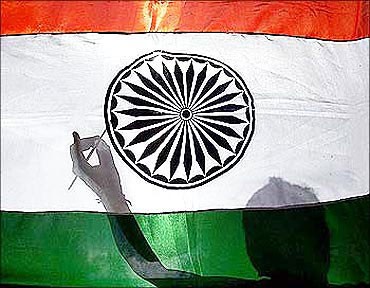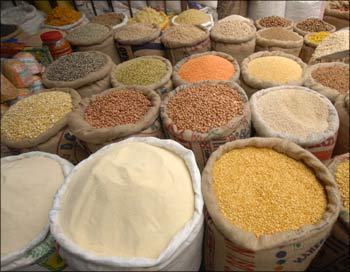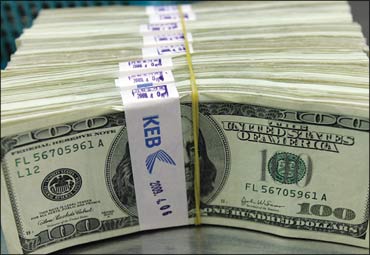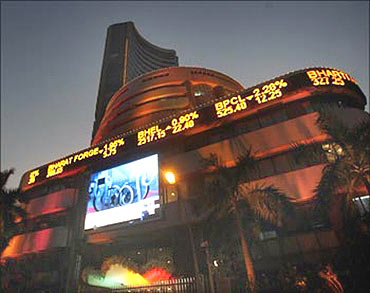Photographs: Reuters
Amid a difficult global economic scenario, India's GDP growth will slow down to 8.2 per cent in the current fiscal and the inflation rate is expected to remain high at 9 per cent till October, the Prime Minister's Economic Advisory Council said on Monday.
In its report on the state of economy, the PMEAC said: "The projected growth rate of 8.2 per cent, though lower than the previous year, must be treated as high and respectable given the current world situation."
It further said that the global economic and financial situation was unlikely to improve (in the foreseeable future) and this could impact the domestic economy.
. . .
India to boom at 8.2%, but FII funds may slump by 46%
Photographs: Reuters
The Indian economy grew by 8.5 per cent in the last fiscal, ended March 31, 2011.
The PMEAC's projection for 2011-12 is higher than the 8 per cent growth forecast made by the Reserve Bank of India in its annual Monetary Policy, but it is lower than the government's target of 8.5 per cent.
On inflation, the PMEAC said that it was likely to come down to 6.5 per cent by March, 2012, but would remain high at 9 per cent till October.
"There will be some relief starting from November and (inflation) will decline to 6.5 per cent by March, 2012," it said.
. . .
India to boom at 8.2%, but FII funds may slump by 46%
Photographs: Reuters
Hinting at further interest rate hikes, the PMEAC also said the RBI would have to continue with its monetary tightening policy measures to contain inflation.
The RBI has already hiked benchmark rates 11 times since March, 2010, as part of efforts to tame inflation. Headline inflation has been above 9 per cent since December, 2010.
To contain inflation, the PMEAC suggested that the government liberally release food stocks.
"Important role for fiscal policy (is) to contain demand pressure. (There is also) need to ensure that the fiscal deficit does not exceed the budgeted level," it said.
. . .
India to boom at 8.2%, but FII funds may slump by 46%
Photographs: Reuters
The PMEAC asked the government to increase its efforts for revenue collection and to reduce cases of tax arrears.
It also suggested minimising avoidable expenditure and resolving the issues with states that are holding up introduction of Goods and Services Tax (GST).
The PMEAC report also said that capital flows this fiscal were likely to rise to $72 billion from $61.9 billion in 2010-11.
The FDI inflows were projected at $35 billion, up from $23.4 billion in 2010-11. However, the FIIs were likely to infuse just $14 billion, less than half of the $30.3 billion they pumped into the country in the previous fiscal.
. . .
India to boom at 8.2%, but FII funds may slump by 46%
Photographs: Reuters
Among the key concerns for the economy, the PMEAC said there was disparity among the states in terms of growth.
For the power sector, it called for reforms and immediate policy measures to ensure coal availability, smooth land acquisition and environment clearances.
It also pitched for food security by way of providing a legal entitlement to the poor to subsidised food through appropriate legislative measures.
It also called for reforms in the PDS (Public Distribution System) by way of computerisation, introduction of smart cards and use of unique identification numbers.
. . .
India to boom at 8.2%, but FII funds may slump by 46%
Photographs: Dominic Xavier/Rediff.com
Highlights of the PM's EAC report
- Economy to grow at 8.2% in 2011-12.
- Agriculture grew at 6.6% in 2010-11. Projected to grow at 3.0% in 2011-12.
- Industry grew at 7.9% in 2010-11. Projected to grow at 7.1% in 2011-12.
- Services grew at 9.4% in 2009-10. Projected to grow at 10.0% in 2011-12.
- The projected growth rate of 8.2%, though lower than the previous year, must be treated as high and respectable, given the current world situation.
- Global economic and financial situation unlikely to improve.
- To keep the economy growing at 9% it is important to increase fixed investment rate.
. . .
India to boom at 8.2%, but FII funds may slump by 46%
Photographs: Reuters
- Investment rate projected at 36.4% in 2010-11 and 36.7% in 2011-12.
- Domestic savings rate as ratio of GDP projected at 33.8% in 2010-11 & 34.0% in 2011-12.
- The 2011 monsoon projected to be in the range of 90 to 96 per cent of Long Period Average. As a result farm sector output expected to grow at 3%.
- The revised series (2004/05) for Index of Industrial Production shows an output growth pattern that is fairly different from what the old series (1993/94) had indicated.
- The output growth was grossly underestimated by the old series in 2007-08 and overestimated in 2008-09 and 2009-10.
- The impact of the global crisis on industrial output was much stronger than had been indicated by the old series.
- In 2010-11 the output growth was higher at 8.2% against 7.8% indicated by the old series.
. . .
India to boom at 8.2%, but FII funds may slump by 46%
Photographs: Reuters
- Current Account deficit is $44.3 billion (2.6% of GDP) in 2010-11 and projected at $54.0 billion (2.7% of GDP) in 2011-12.
- Merchandise trade deficit is $ 130.5 billion or 7.59% of the GDP in 2010-11 and projected at $154.0 billion or 7.7% of GDP in 2011-12.
- Invisibles trade surplus is $ 86.2 billion or 5.0% of the GDP in 2010-11 and projected at $100.0 billion or 5.0% in 2011-12.
- Capital flows at $61.9 billion in 2010-11 and projected at $72.0 billion in 2011-12.
- FDI inflows projected at $35 billion in 2011/12 against the level of $23.4 billion in 2010-11.
- FII inflows projected to be $14 billion which is less than half that of the last year, i.e $30.3 billion.
- Accretion to reserves was $15.2 billion in 2010-11. Projected at $18.0 billion in 2011-12.
. . .
India to boom at 8.2%, but FII funds may slump by 46%
Photographs: Reuters
- Inflation rate projected at 6.5 % in March 2012.
- The headline inflation rate would continue to be at 9 per cent in the month of July-October 2011. There will be some relief starting from November and will decline to 6.5% in March 2012.
- Available food stocks to be liberally released.
- Important role for fiscal policy to contain demand pressure. Need to ensure that fiscal deficit does not exceed the budgeted level.
- RBI will have to continue to follow a tight monetary policy till inflation shows definite signs of decline.
- Achieving fiscal targets set in 2011/12 Budget estimates to present a significant challenge.
- For 2011/12, budget estimates of fiscal deficit for Centre - 4.7%; States- 2.1% and consolidated fiscal deficit including off budget liabilities -- 6.8%
- Government to redouble efforts to collect larger revenue, resolve cases to reduce tax arrears.
. . .
India to boom at 8.2%, but FII funds may slump by 46%
Photographs: Reuters
- Minimize avoidable expenditures and initiate measures to increase revenues.
- Resolve issues with states and introduce Goods and Services Tax.
- Reforms in power sector distribution system to limit the liabilities of state governments.
Some key issues of concern
- Convergence of growth rates of states: An analysis of the recent data indicates that while most of the lower income states have shown stronger growth rates, several of the higher income states have also shown an increase.
- Current Account Deficit: Given our growth needs, a moderate trade deficit and CAD are inevitable. To finance the CAD, foreign investment flows need to be promoted. However CAD to be contained below 2.5% of the GDP.
- Power sector: The India growth story inextricably linked to the power sector. Immediate policy interventions required for ensuring coal availability for the power plants, land acquisition and environmental clearances and revision of power tariff by states to reduce high AT&C losses.
. . .
India to boom at 8.2%, but FII funds may slump by 46%
Photographs: Reuters
- Increased focus on non conventional energy.
- Food security: Need to grant the poor a legal entitlement to food through an appropriate legislative enactment.
- Availability of grain to be kept in mind while deciding legal entitlements.
- Reforms in PDS important to strengthen distribution.
- Computerisation, introduction of smart cards and using unique identification numbers for the beneficiaries are important interventions.












article